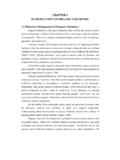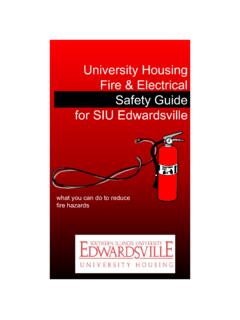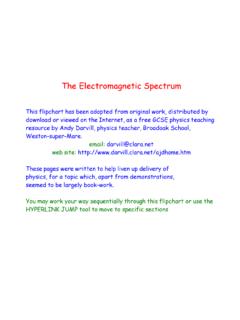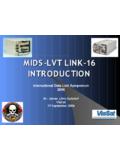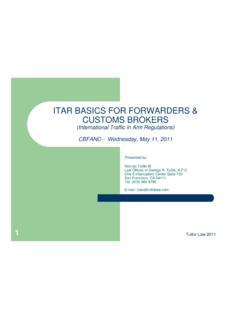Transcription of Decibel Table Loudness Comparison Chart •
1 Deutsche Version Decibel Table Loudness Comparison Chart Table of Sound Levels (dB Scale) and the correspondingUnits of Sound Pressure and Sound Intensity (Examples)To get a feeling for decibels, look at the Table below which gives values for thesound pressure levels of common sounds in our environment. Also shown are thecorresponding sound pressures and sound these you can see that the Decibel scale gives numbers in a much moremanageable range. Sound pressure levels are measured without weighting values are averaged and can differ about 10 dB. With sound pressure isalways meant the effective value (RMS) of the sound pressure, without extraannouncement. The amplitude of the sound pressure means the peak ear is a sound pressure receptor, or a sound pressure sensor, theear-drums are moved by the sound pressure, a sound field quantity. It is not anenergy receiver. When listening, forget the sound intensity as energy perceived sound consists of periodic pressure fluctuations around astationary mean (equal atmospheric pressure).
2 This is the change of sound pressure, which is measured in pascal (Pa) 1 N/m2 1 J / m3 1 kg / (m s2). Usually p is the RMS of sound levels L ( Loudness ) andcorresponding sound pressure and sound intensitySound SourcesExamples with distanceSound PressureLevel Lp dBSPLS ound Pressure p N/m2 = PaSound Intensity I W/m2 Jet aircraft, 50 m away140200100 Threshold of of discomfort120201 Chainsaw, 1 m , 1 m from truck, 10 m away of busy road, 5 m cleaner, distance 1 m speech, 1 m home library bedroom at night in TV studio leaves in the distance of hearing Chart sound pressure levels The sound level depends on the distance between the sound source and the place of measurement, possibly one ear of a listener. The sound pressure level Lp in dB without the given distance r to the sound source is really meaningless. Unfortunately this error (unknown distance) is quite often. Noise is a sound that disturbs or : The maximum sound pressure is 194 dBSPL.
3 That cannot beexceeded because the average air pressure of 101325 = 20 log (101325 / 0,00002) = 194 dB. This theoretical idea is not correct,because a chaotic noise can also be is no upper noise limit. A typical false statement: "No noise levels canexceed 194 dB ever". Is the end at 194 dB? In addition to this perceptionthreshold is discussed more often a physical limit to 194 dB. Sound isnothing more than a minor disturbance of air pressure and 194 dB istheoretically the same as the disturbance itself. But even louder noise is between 20 kHz and GHz does not belong to our human below about 16 Hz is insensitive to the human total sound power is emitted by the sound source. Sound power levelsare connected to the sound source and are independent of pressure levels vary substantially with distance from the source. Sound pressure p in pascals (newtons per square meter) is not the same physical quantity as intensity J or I in watts per square meter.
4 And the sound power (acoustic power) does not decrease with distance r from the sound source - neither with 1 / r nor as 1 / r2. Sound Field Quantities Sound pressure, sound or particle velocity,particle displacement or particle amplitude,(voltage, current, electric resistance).Inverse Distance Law 1/rSound Energy QuantitiesSound i ntensi ty, sound energy densi ty,sound energy, acoustic power.(electrical power).Inverse Square Law 1/r The reference sound pressure level for 0 dBSPL is the sound pressurep0 = 20 Pa = 20 10 6 Pa = 2 10 5 Pa = Pa or N/m . That isthe threshold of hearing. (The reference sound intensity is I0 = 10 12 W/m2.)Pa = is no "dBA" value given as threshold of human values are not given as dBA, but as dBSPL, that means without anyweighting Chart sound pressure levels between sound pressure p as a "sound field quantity" andsound i ntensi ty I as a "sound energy quantity". I p2 for progressive plane it comes to our ears and the hearing, it is recommended that theinappropriate expression of the sound energy parameters, such as sound power(acoustic power) and sound intensity to leave aside.
5 So we are just listening to thesound pressure as sound field quantity, or the sound pressure level sound pressure level decreases in the free field with 6 dB per distance is the 1/r it is argued the sound pressure would decrease after the 1/r2 law(inverse square law). That's sound pressure in a free field is inversely proportional to the distance from themicrophone to the source. p ~ 1 does the sound decrease with increasing distance?Damping of sound level with distanceRelation of sound intensity, sound pressure and distance law: From this follows Note: The often used term "intensity of sound pressure" is not "magnitude", "strength", "amplitude", or "level" instead."Sound intensity" is sound power per unit area, while "pressure" is ameasure of force per unit area. Intensity (sound energy quantity) is notequivalent to pressure (sound field quantity).dB scale for field quantities, like volts and sound pressuresratioThe sound pressure is the force F in newtons N of a sound on a surfacearea A in m2 perpendicular to the direction of the SI-unit for the sound pressure p is N/m2 = Pa.
6 P ~ 1 - Comparing dBSPL and dBA: There is no conversion formula for measured dBA values to sound pressure level dBSPL or vice versa. That is only possible measuring one single Chart sound pressure levels is no "dBA" curve given as threshold of human weighted sound level is neither a physiological nor aphysical parameter. Words to bright minds: Always wonder what a manufacturer is hiding when they use A-weighting. *) *) +wonder+what+a+manufacturer+Rane&filter= 0 Readings of a pure 1 kHz tone should be identical, whether weighted or loud is dangerous?Typical dbA levels190 dBA Heavy weapons, 10 m behind the weapon (maximum level)180 dBA Toy pistol fired close to ear (maximum level)170 dBASlap on the ear, fire cracker explodes on shoulder, small armsat a distance of 50 cm (maximum level)160 dBAHammer stroke on brass tubing or steel plate at 1 m distance,airbag deployment very close at a distance of 30 cm (maximum level)150 dBA Hammer stroke in a smithy at 5 m distance (maximum level)130 dBA Loud hand clapping at 1 m distance (maximum level)120 dBA Whistle at 1 m distance, test run of a jet at 15 m distance Threshold of pain, above this fast-acting hearing damage in short action is possible115 dBA Take-off sound of planes at 10 m distance110 dBASiren at 10 m distance, frequent sound level in discotheques and closeto loudspeakers at rock concerts, violin close to the ear of an orchestramusicians (maximum level)
7 105 dBAChain saw at 1 m distance, banging car door at 1 m distance (maximum level),racing car at 40 m distance, possible level with music head phones100 dBA Frequent level with music via head phones, jack hammer at 10 m distance95 dBA Loud crying, hand circular saw at 1 m distance90 dBA Angle grinder outside at 1 m distance Over a duration of 40 hours a week hearing damage is possible85 dBA 2-stroke chain-saw at 10 m distance, loud WC flush at 1 m distance80 dBAVery loud traffic noise of passing lorries at m distance,high traffic on an expressway at 25 m distance75 dBA Passing car at m distance, un-silenced wood shredder at 10 m distance70 dBA Level close to a main road by day, quiet hair dryer at 1 m distance to ear65 dBABad risk of heart circulation disease at constant impact is possible60 dBA Noisy lawn mower at 10 m distance55 dBALow volume of radio or TV at 1 m distance, noisy vacuum cleaner at10 m distance50 dBA Refrigerator at 1 m distance, bird twitter outside at 15 m distance45 dBA Noise of normal living.
8 Talking, or radio in the background40 dBADistraction when learning or concentration is possible35 dBA Very quiet room fan at low speed at 1 m distance25 dBA Sound of breathing at 1 m distance0 dBA Auditory threshold1/29/2011 Table Chart sound pressure levels a dB-A measurement no accurate description of the expected noise volume is of the Threshold of painWhat is the threshold of pain?You can find the following rounded values in various audio articles:Sound pressure levelLp Sound pressure p 140 dBSPL200 Pa dBSPL150 Pa 134 dBSPL100 Pa 120 dBSPL 20 PaThe Psychoacoustic LoudnessNotice: Psycho acousticians tell us, that a 10 dB increase of levelgive the impression of the doubling the Loudness (volume).Your loudspeakers need 10 times more you have 6 violins as source, then you have to ten times the violins;you need 60 violins to double the psycho-acoustic Loudness (volume).Half Loudness level: 10 dB Double Loudness level: +10 dBHalf sound pressure level: 6 dB Double sound pressure level: +6 dBHalf power level: 3 dB Double power: level +3 dBfour times power level: +6 dB Ten times power level: +10 dBDouble distance level: 6 dB Double sources (Double power) +3 dBSound Level Comparison Chart and the RatiosTable of sound level dependence and the change of the respective ratio to subjectivevolume ( Loudness ), objective sound pressure (voltage), and sound intensity (acoustic power)How many decibels (dB) change is double, half, or four times as loud?
9 How many dB to appear twice as loud (two times)? Here are all the different means "how many times" or "how much" .. Doubling of Loudness . Subjectively perceived Loudness (volume),objectively measured sound pressure (voltage), andtheoretically calculated sound intensity (acoustic power) LevelChangeVolumeLoudnessVoltageSound pressureAcoustic Power Sound Intensity+40 dB16100 10000+30 dB 8 +20 dB 410100+10 dB = double = 1010 +6 dB times = double Chart sound pressure levels +3 dB times = 2 = double - - - - 0 dB - - - - - - - - - - - - - - -- - - - - - - - - - - - - - - - - - - - - 3 dB times times = half 6 dB times = 10 dB = 20 dB 30 dB 40 dB quantityPsycho quantityField quantityEnergy quantitydB changeLoudness multipl. Amplitude multiplier Power multiplierThe psycho-acoustic volume or Loudness is a subjective sensation a 10 dB or 6 dB sound level change for a doubling or halving of the Loudness (volume) correct?
10 About the connection between sound level and Loudness , there are various theories. Far spread is still thetheory of psycho-acoustic pioneer Stanley Smith Stevens, indicating that the doubling or halving thesensation of Loudness corresponds to a level difference of 10 dB. Recent research by Richard M. Warren,on the other hand leads to a level difference of only 6 dB. *) This means that a double sound pressurecorresponds to a double Loudness . The psychologist John G. Neuhoff found out that for the rising level ourhearing is more sensitive than for the declining level. For the same sound level difference the change ofloudness from quiet to loud is stronger than from loud to is suggested that the sone scale of Loudness reflects the influence of known experimental biases andhence does not represent a fundamental relation between stimulus and sensation.*) Richard M. Warren, "Elimination of Biases in Loudness Judgments for Tones"It follows that the determination of the volume ( Loudness ) which is double as loud should notbe dogmatically defined.

